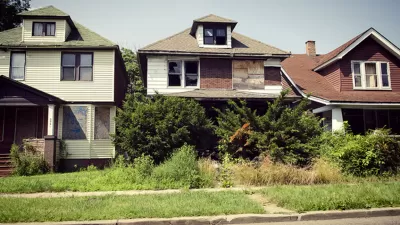Urban homesteading as a response to hypervacancy is in the news after South Bend Mayor Pete Buttigieg proposed the Douglass Plan while on the presidential campaign trail.

Joseph Schilling and Brian Bieretz write on the subject of vacant and abandoned properties, suggesting collaborative and comprehensive strategies to respond to a complex problem.
The problem’s scope and impact vary among cities and neighborhoods, depending on the relative strengths or weaknesses of the regional economy, local housing market, and local government capacity. In older industrial legacy cities, such as Baltimore and Detroit, hypervacancy creates a dynamic where some neighborhoods are undergoing gentrification while others nearby are plagued by blighted buildings and less economic opportunity.
The article is written in response to a policy announcement made by South Bend Mayor Pete Buttigieg, also a Democratic candidate for president, at the end of July, proposing a federal policy, called the Douglas Plan, resembling the urban homesteading popular during the 1970s.
Kriston Capps reported on Buttigieg's proposal in an earlier post for CityLab, describing the Douglass Plan as an attempt to bridge the racial wealth gap, prioritize environmental equity, and reform the criminal justice system. "Embedded within that plan is a housing proposal for the parts of America that are still reeling from the Great Recession, a plan that would promote homeownership by targeting hypervacancy," writes Capps.
Under the Buttigieg proposal, cities would bid for comprehensive financing under a new Homeownership Fund (operated by the U.S. Department of Housing and Urban Development). Pilot cities would establish a land bank to acquire and develop abandoned or foreclosed properties. A special-purpose trust (also administered by HUD) would purchase those properties and provide funds for restoring them. An eligible homesteader would then be granted the property to use as a primary residence—and after 10 years, the homesteader would own the property free and clear.
According to Schilling and Bieretz, however, homesteading only works for a portion of a city's vacant properties. "The plan would likely work best in middle neighborhoods [pdf] with modest property abandonment, some threshold market strength, and community-based organizations and capacities. The homes must also be in good physical condition, where it makes financial sense to rehabilitate them," according to the article.
To help ensure an effective strategy for vacant and abandoned properties, Schilling and Bieretz have created a list of five elements necessary to reclaim vacant properties and revitalize struggling neighborhoods:
- Comprehensive property data and information infrastructure.
- Resources for land banking.
- Strategic code enforcement.
- Public and private resources.
- Civic infrastructure and community stewardship.
FULL STORY: Five Elements Cities Need to Address "Hypervacancy" and Catalyze Neighborhood Recovery

Maui's Vacation Rental Debate Turns Ugly
Verbal attacks, misinformation campaigns and fistfights plague a high-stakes debate to convert thousands of vacation rentals into long-term housing.

Planetizen Federal Action Tracker
A weekly monitor of how Trump’s orders and actions are impacting planners and planning in America.

In Urban Planning, AI Prompting Could be the New Design Thinking
Creativity has long been key to great urban design. What if we see AI as our new creative partner?

Florida Seniors Face Rising Homelessness Risk
High housing costs are pushing more seniors, many of them on a fixed income, into homelessness.

Massachusetts Budget Helps Close MBTA Budget Gap
The budget signed by Gov. Maura Healey includes $470 million in MBTA funding for the next fiscal year.

Milwaukee Launches Vision Zero Plan
Seven years after the city signed its Complete Streets Policy, the city is doubling down on its efforts to eliminate traffic deaths.
Urban Design for Planners 1: Software Tools
This six-course series explores essential urban design concepts using open source software and equips planners with the tools they need to participate fully in the urban design process.
Planning for Universal Design
Learn the tools for implementing Universal Design in planning regulations.
Gallatin County Department of Planning & Community Development
Heyer Gruel & Associates PA
JM Goldson LLC
City of Camden Redevelopment Agency
City of Astoria
Transportation Research & Education Center (TREC) at Portland State University
Jefferson Parish Government
Camden Redevelopment Agency
City of Claremont





























